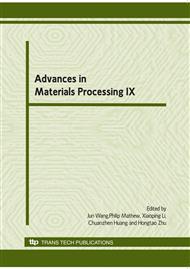p.140
p.146
p.152
p.158
p.164
p.170
p.177
p.183
p.189
The Effect of Heat Treatment on Formability of Ultra-Fine Grained AA6061 for Bolt Manufacturing
Abstract:
Equal channel angular extrusion (ECAE) was used before and after artificial aging to investigate the effect of heat treatment on formability of bulk nanostructure of commercially available aluminum alloy of AA6061 in the present study. In the ECAE, route A was applied up to four or eight passes by using the split dies set-up. The three-stage bolt forming using the ultra-fine grained specimens was carried out to check formability of the material. In the present experiments, the bolt forming was successful with the specimen prepared by the ECAE after artificial aging whilst it was not successful with the specimen prepared by a reverse process sequence. The strength increase was confirmed by the tension and microhardness tests and compared to the result of conventional AA2024 bolt made by the conventionally heat treated specimen. It was found that the strength was comparable to the level of the heat treated conventional one although the actual value was a little bit lower. In addition, it was demonstrated that the heat treatment sequence is important to achieve proper formability of the ultra-fine grained material to manufacture the high strength bolt.
Info:
Periodical:
Pages:
164-169
Citation:
Online since:
June 2010
Authors:
Keywords:
Price:
Сopyright:
© 2010 Trans Tech Publications Ltd. All Rights Reserved
Share:
Citation:


